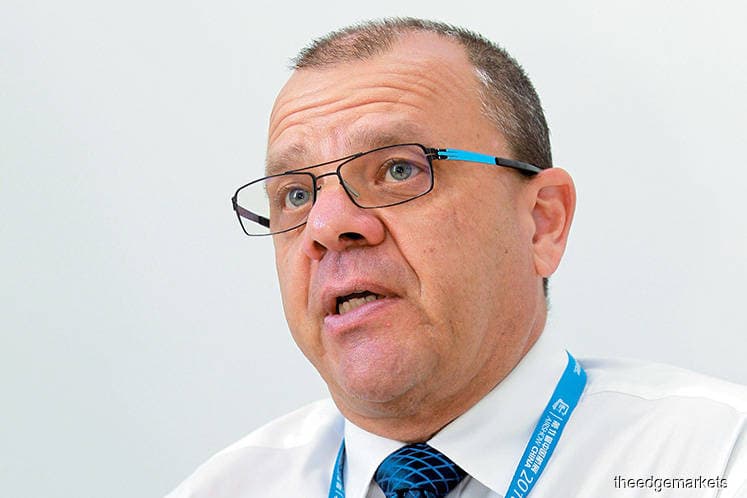
This article first appeared in The Edge Financial Daily on October 16, 2017
KUALA LUMPUR: Safety enhancements are often associated with higher expenditure on preventive amenities for the aviation business, but US-based Honeywell International Inc is out to change the notion with its “connected aircraft” solutions.
The solutions keep aircraft away from hazards, while helping airlines to be more economical.
Honeywell’s air transport and regional commercial aerospace vice-president for Asia-Pacific, Brian Davis, said the solutions are particularly relevant in the rapidly growing aviation industry in Southeast Asia as air travel demand increases.
“In terms of passengers and planes, our statistics showed that Malaysia was up 10.4% year-on-year in the first three months of this year. Think about it, [assuming the remaining] three quarters of 2017 also show about 10% in growth rate, that is just a great amount of surge in growth for Malaysia, as well as the Asean region,” he told The Edge Financial Daily in an interview.
Aviation safety has been a widely discussed topic in Malaysia over the past few months after a spate of incidents involving Malaysian aircraft at a time when Chinese tourists are coming to Malaysia in droves.
On June 25, an AirAsia X Bhd flight bound for Kuala Lumpur from Perth, Australia, turned around due to technical issues. While investigations are still ongoing, the Australian investigator’s interim report in August blamed metal fatigue of a fan blade as the cause for the Airbus A330’s engine failure.
In early July, two Malindo Airways Sdn Bhd aircraft were grounded in Bangladesh and India due to technical issues. The incident gained traction in the media as disgruntled passengers took to social media to complain about the disruption to their flights.
Davis said the connected aircraft solutions work by using satellite connection on the plane to download parts maintenance and fault data to predict impending hardware failures. Such fault data is then shared with Honeywell and analysed before being presented to the airline’s maintenance team in an easy-to-understand, visual manner.
He added that this analysis identifies what maintenance actions are required to fix the parts and avoid an unscheduled maintenance event.
“Take Cathay Pacific Airways as an example. The Hong Kong-based airline signed an agreement with us last year to have us monitor their Airbus A330 fleet’s auxiliary power units (APUs) — the engine at the back [of an aircraft] that cools the aircraft on the ground and gives it electrical power,” said Davis.
“In the last 30 years, APUs have always been around. The technology is not new, but what is new is we have found a way to connect to the aircraft and now we can look at different things on that APU that may cause it to fail. And, before it fails, we will send a message to the airline, telling them that they should proactively replace the parts that our system has pointed out,” he said.
Davis said Honeywell’s solution has resulted in a 35% reduction in operational disruptions at Cathay Pacific.
“Managing unscheduled maintenance events can be both costly and time-consuming for airlines. The APU monitoring system can save Cathay Pacific several hundreds [of] thousands of dollars in operations and maintenance costs on a single aircraft system,” he said.
Meanwhile, Honeywell has chosen Kuala Lumpur as its aftermarket headquarters to further strengthen its presence in Southeast Asia.
Davis said Honeywell’s newly established aftermarket headquarters in Kuala Lumpur will house decision-making level executives to accelerate response time to customers.
“We thought that it was important to support the growth in Asean, as well as Malaysia, while making sure that we have not only the leadership, but we have all of the [relevant] decision-makers in the region, and that is of significant difference. A very important part of our growth in Asia is to make sure that we have all of these people and in the right time zone,” he added.
Davis noted that going forward, Honeywell is expecting 50% of its future growth to come from high growth regions, including Asean.
“You’ve got to have people that are proud of the Honeywell brand, our integrity and our high compliance standard, and there is no way that you are ever going to get that message across to customers if you do that out of the US or Europe. So, we have to be here with the people to take advantage of the growth,” he said.
Honeywell currently employs 400 people at the headquarters, who form part of the diversified group’s total workforce of 1,500 in Malaysia. The other staff work at its production facility in Penang and a regional distribution centre in Kuala Lumpur.
Aerospace is Honeywell’s largest revenue contributor globally.
In the first half of its financial year ending Dec 31, 2017, the Fortune 100 company recorded US$7.22 billion (RM30.47 billion) sales from its aerospace business, equivalent to 36.89% of the US$19.57 billion total turnover.
This was followed by US$5.23 billion from home and building technologies businesses, US$4.31 billion from performance materials and technologies division, and lastly US$2.16 billion from the provision of safety and productivity solutions.